
Negeri Sembilan, historically spelled as Negri Sembilan, is a state in Malaysia which lies on the western coast of Peninsular Malaysia. It borders Selangor on the north, Pahang in the east, and Malacca and Johor to the south.

The Undang Yang Empat are the ruling chiefs or territorial chiefs who still play an important role in the state of Negeri Sembilan, Malaysia, namely in the election of a new Yang di-Pertuan Besar. The name is believed to be derived from the Malay word undang-undang meaning "law".
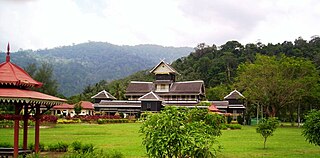
Seri Menanti is a town, a mukim and a state assembly constituency in Kuala Pilah District, central Negeri Sembilan, Malaysia, located 33 km east of the state capital city of Seremban and 14 km southwest of Kuala Pilah. It is the royal capital of the state of Negeri Sembilan and houses the seat of the Yang Di-Pertuan Besar of Negeri Sembilan or Yamtuan Besar, the ruler of the state of Negeri Sembilan. The royal palace is known as Istana Besar.
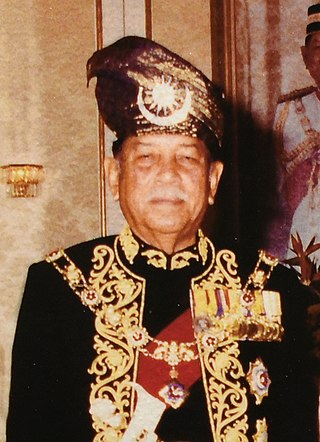
Tuanku Ja’afar ibni Almarhum Tuanku Abdul Rahman was Yang Di-Pertuan Besar of Negeri Sembilan from 1967 until his death in 2008, and previously the tenth Yang di-Pertuan Agong, the constitutional monarch of Malaysia, from 1994 to 1999.

Tuanku Muhriz ibni Almarhum Tuanku Munawir is the eleventh Yang di-Pertuan Besar of Negeri Sembilan, Malaysia. He is only prince out of six siblings of royal couples, the ninth Yang di-Pertuan Besar of Negeri Sembilan Tuanku Munawir and his spouse, Tunku Ampuan Durah.

The coat of arms of Malaysia is a coat of arms comprising a shield or escutcheon, two tigers for supporters, a crescent and fourteen-pointed star for a crest and a motto. As the Malaysian coat of arms descended from that of the Federated Malay States under British colonial rule, it resembles European heraldic designs.
The flag and the coat of arms of Perlis are state symbols of Perlis, a state in Malaysia. centering on Perlis' monarch and agricultural activities, its flag and arms are similar in symbolisation as the state symbols of Kedah, which it neighbours.

Tampin is a town in Tampin District, Negeri Sembilan, Malaysia, which borders Pulau Sebang town in Alor Gajah District, Malacca. It is situated at the southern tip of the longest mountain range in Malaysia, the Titiwangsa Mountains.
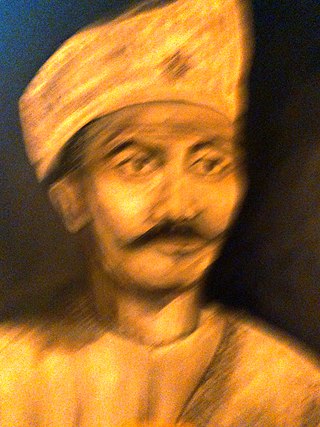
Raja Mahmud ibni Almarhum Sultan Abdul Jalil, known as Raja Melewar, was the first Yamtuan Besar of Negeri Sembilan, Malaysia. He was a prince from the Pagaruyung Kingdom in the island of Sumatra, now situated within Indonesia.

The Kuala Pilah District is a district in central Negeri Sembilan, Malaysia. Its seat is the town of Kuala Pilah.

Johol is a town, a mukim and a state assembly constituency in Kuala Pilah District, Negeri Sembilan, Malaysia. It is roughly halfway between Tampin and Kuala Pilah, along FT 9.

Yamtuan Besar, also known officially as Yang di-Pertuan Besar and unofficially as Grand Ruler, is the royal title of the ruler of the Malaysian state of Negeri Sembilan. The Grand Ruler of Negeri Sembilan is elected by a council of ruling chiefs in the state, or the Undangs. This royal practice has been followed since 1773. The Yamtuan Besar is elected from among the four leading princes of Negeri Sembilan ; the Undangs themselves cannot stand for election and their choice of a ruler is limited to a male Muslim who is Malay and also a "lawfully begotten descendant of Raja Radin ibni Raja Lenggang", the 4th Yamtuan.
There are three palaces in Seri Menanti, the royal capital of Negeri Sembilan, Malaysia: Istana Besar, Istana Lama and Istana Tasik.
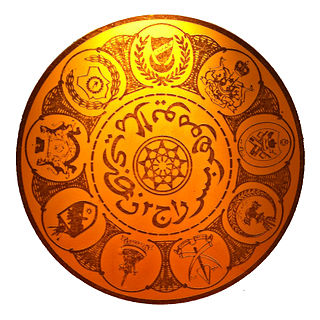
The monarchies of Malaysia exist in each of the nine Malay states under the constitutional monarchy system as practised in Malaysia. The political system of Malaysia is based on the Westminster parliamentary system in combination with features of a federation.
Negeri Sembilan Malay is an Austronesian language spoken mainly in the Malaysian state of Negeri Sembilan, including Alor Gajah and parts of Jasin District in northern Malacca, and parts of Segamat District in the northernmost part of Johor. The language is spoken by the descendants of Minangkabau settlers from Sumatra, who have migrated to Negeri Sembilan since as early as the 14th century. It is often considered a variant or dialect of the Minangkabau language; lexical and phonological studies, however, indicate that it is more closely related to Standard Malay than it is to Minangkabau.
Tuanku Antah ibni Almarhum Yamtuan Radin was the sixth Yamtuan Besar of Negri Sembilan. He ruled from 1869 to 1888, and tried to keep Negeri Sembilan independent from British rule. His son Tuanku Muhammad Shah succeeded him and modernised his state.

The Rembau District is a district that is located in the state of Negeri Sembilan, Malaysia. The district is a stronghold of the matrilineal system known as adat perpatih, a customary practice inherited from the Minangkabaus, of Sumatra. The district borders Seremban District to the north, Port Dickson District to the west, Tampin District to the east, Kuala Pilah District to the northeast and Alor Gajah District, Malacca to the southwest.
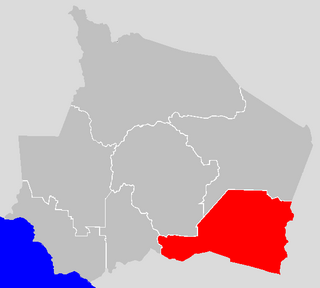
The Tampin District is a district in Negeri Sembilan, Malaysia. The district covers 878.69 square kilometres (339.26 sq mi) and is further divided into four adat socio-political provinces (luaks): Tampin Adat Territory, Ayer Kuning, Gemencheh and Pasir Besar.
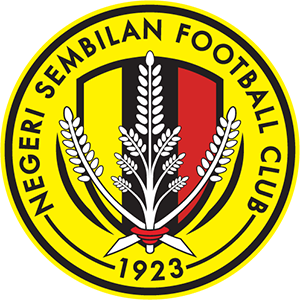
Negeri Sembilan Football Club, commonly referred to as Negeri Sembilan or simply NSFC, is a Malaysian professional football club based in Seremban, Negeri Sembilan, Malaysia. The club competes in the top division of Malaysian football, the Malaysia Super League.
Negeri Sembilan Football Association (NSFA), commonly referred to as PBNS, is a sports association that is responsible for handling association football sports affairs in Negeri Sembilan. This association is also the owner of Negeri Sembilan FC. PBNS is an association registered with the Office of the Sports Commissioner of Malaysia and one of the affiliates of the Football Association of Malaysia (FAM). PBNS is currently led by the President of PBNS, Tunku Syed Razman bin Tunku Syed Idrus Al-Qadri, who is also Tunku Besar Tampin.

 The flag of Negeri Sembilan
The flag of Negeri Sembilan




























